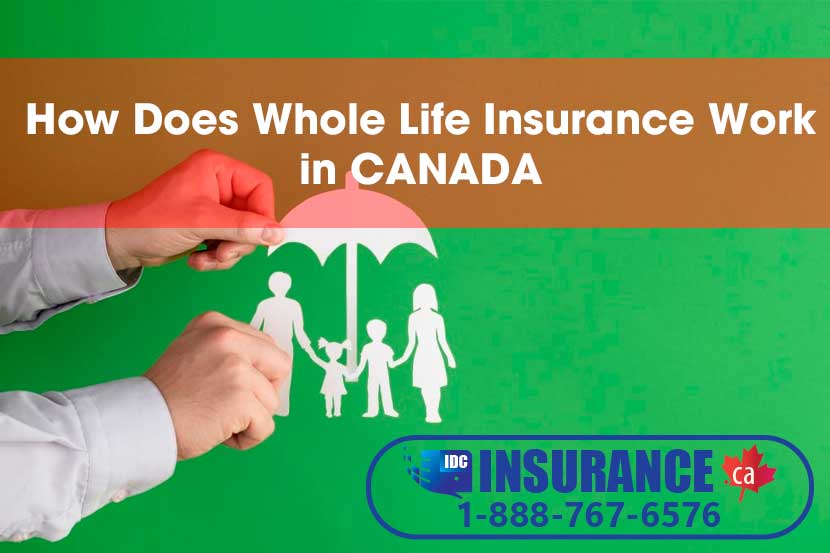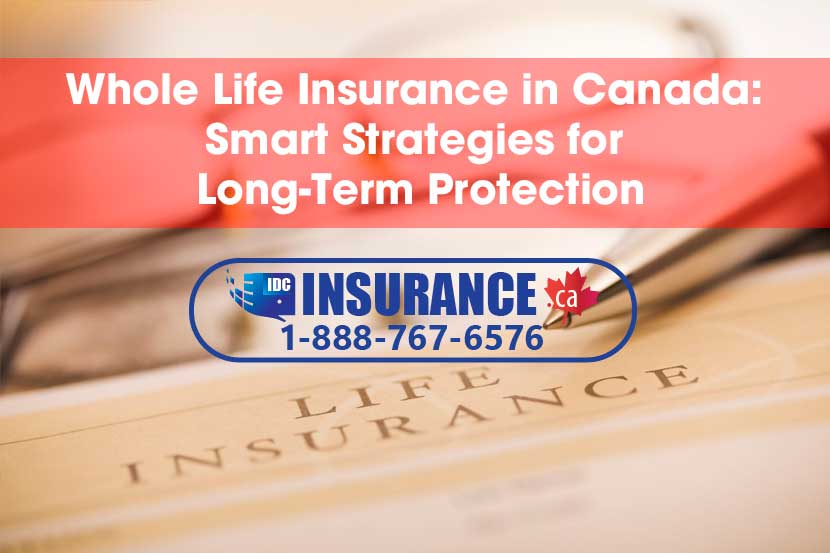Whole life insurance in Canada is one of the most complex personal insurance products available. This comprehensive guide answers all the key questions in plain terms to help you understand if whole life insurance is a wise choice based on your needs and situation.
What is Whole Life Insurance in Canada ?
Whole life insurance is a form of permanent life insurance designed to provide lifetime protection as long as premiums continue to be paid.
Unlike term life insurance, which covers you for a defined period, whole life insurance remains in force your entire lifetime. Below are the key attributes:
- Lifelong Coverage: Whole life provides permanent protection that never expires, given you pay the premiums. You don’t ever have to reapply or requalify.
- Level Premiums: Whole life premiums are fixed and remain unchanged for the duration of the policy. This allows stable budgeting.
- Cash Value Savings: Part of your premiums go toward building cash value that grows tax-deferred. Many policies offer dividends to boost returns.
- Death Benefit Payout: Upon death, the policy pays income tax-free proceeds to your named beneficiaries. This can cover debts, taxes, and more.
- Policy Loans: Most whole life policies allow you to borrow against the accumulated cash value if needed. Interest charges apply.
- Limited Flexibility: The premiums, death benefit, and cash value elements are locked in. This contrasts with adjustable universal life insurance.
Read more : what is whole life insurance
What are the Different Types of Whole Life Insurance?
There are several varieties of whole life insurance available in Canada :
- Traditional Whole Life: This is the original version where premiums, death benefit, and cash value remain unchanged for life. It has fixed, guaranteed elements.
- Participating Whole Life: The most common type in Canada. It has guaranteed premiums and death benefit, but also pays dividends from the insurer’s profits to boost cash value.
- Limited-Pay Whole Life: Allows you to pay premiums for a set period, such as 20 years, after which coverage continues but no more payments are due. The premiums are higher to prepay the cost of lifetime coverage.
- Single Premium Whole Life: A lump-sum payment that pre-pays for the policy, requiring no further premiums. The large upfront payment can have tax implications.
- Universal Life: A form of permanent insurance with flexible premiums and adjustable death benefit and cash value growth. Investment earnings vary based on market interest rates.
The main differences have to do with the payments duration and cash value characteristics. Participating whole life is most common for its dividends feature. Consulting with an advisor can help determine the variety that aligns with your budget and needs.
How Does Whole Life Insurance Work in Canada?
With whole life insurance, part of your premiums go toward the cost of insurance, while the remainder gets invested by the insurer to build cash value.

The cash value grows at a minimum guaranteed interest rate stated in your policy terms, typically between 2% and 4%. Insurers also often pay dividends above that minimum based on investment returns.
Over time, provided you keep paying premiums, the cash value portion of your policy grows. Many policies allow taxable withdrawals or policy loans once sufficient cash value has accumulated. This reduces the death benefit.
Upon the insured’s death, the insurer pays out the death benefit tax-free to the designated beneficiaries. The insurance company keeps the policy’s cash value.
Below is an illustration of the inner workings of a whole life insurance policy:
| Stage | Description |
|---|---|
| 1. Premiums | The policyholder pays regular premiums to the insurance company. |
| 2. Allocation | The premiums are split – part goes toward the cost of insurance/fees, and the remainder is invested by the insurer to build cash value. |
| 3. Cash Value Growth | The cash value portion earns interest and dividends, growing on a tax-deferred basis over time. |
| 4. Accessing Cash Value | The policyholder can take loans or withdrawals from the cash value. This reduces the death benefit. |
| 5. Death Benefit | Upon death of the insured, the insurance company pays the death benefit tax-free to the designated beneficiaries. |
This blending of lifelong guaranteed coverage and tax-preferred savings growth is what defines whole life insurance. However, the high premium costs make it impractical for many average Canadians.
What is Participating Whole Life Insurance?
In Canada, the most common form of whole life insurance is participating whole life.
With participating policies, the insurance company effectively shares a portion of their profits with policyholders in the form of dividends.
Dividends are not guaranteed but serve to boost the return on the policy’s cash value above the minimum guaranteed interest rate stated in the policy terms. Dividends can be taken as cash, used to buy more coverage, or reinvested to grow the policy’s cash surrender value.
The key appeal of participating whole life is combining guaranteed permanent coverage with a cash value component that has the potential to earn market-level returns through dividends. However, dividends are variable and should not be overweighted when assessing these policies.
Is Whole Life Insurance a Good Investment Vehicle?
One of the primary benefits insurance agents tout is the ability to grow your cash value on a tax-deferred basis with whole life insurance. But the reality is far more nuanced.
Here are factors to consider regarding whole life insurance as an investment:
- The guaranteed cash value growth rate ranges from only 2% to 4% for most policies. While dividends can boost returns, they are variable and not guaranteed.
- Withdrawing funds reduces the death benefit to your beneficiaries and comes with fees and risks that diminish returns. Accessing cash value is not as seamless as with standalone investment accounts.
- If you die and the death benefit is paid out, the insurance company keeps your policy’s accumulated cash value. This money does not go to beneficiaries.
- Tying up money in an illiquid whole life insurance policy means missing out on years of potential compounded market returns in registered accounts.
While whole life insurance offers unique tax advantages, it rarely makes sense as a primary investment vehicle. The cash value component has expensive embedded costs and historically lags far behind average stock market returns. It functions better as protection.
Wealthy individuals who have fully capitalized registered savings may benefit modestly from the tax-deferred cash value as a supplementary asset. But it should never replace optimized RRSP and TFSA investing.
Who is Whole Life Insurance Best Suited For?
Given the high premium costs, whole life insurance suits a smaller niche of consumers with specialized needs. The main target markets include:
- High Net Worth: Wealthy Canadians who have maxed registered accounts can benefit from the tax-deferred cash value growth and potential extra dividends.
- Lifelong Insurance Needs: Someone with a lifelong condition requiring spousal care or a special needs dependent may need permanent guaranteed coverage.
- Business Owners: Policies are commonly integrated into business buy-sell agreements upon an owner’s death and are used to incentivize executives.
- Estate Planning: Individuals with high net worth can use whole life insurance to transfer wealth to heirs efficiently.
- Young and Healthy: Those in excellent health can purchase affordable permanent coverage early before rates increase with age. This locks in lifetime insurability.
What Are the Pros and Cons of Whole Life Insurance?
Below is an overview of the key potential advantages and disadvantages of whole life insurance as part of financial planning:
Potential Advantages of whole life insurance
- Provides permanent guaranteed coverage for life
- Cash value grows tax-deferred
- Dividends can further boost cash value returns
- Predictable fixed premiums and death benefit
- Can assist with business/estate planning needs
- Locks in insurability when purchased at a young age
Potential Disadvantages of whole life insurance
- Much higher premium costs than term insurance
- Cash value growth rates are typically low
- Minimal flexibility compared to universal life
- Tied to one insurance company’s financial strength
- Withdrawing cash value reduces the death benefit
- The opportunity cost of investable funds
For many middle-income families, the drawbacks tend to outweigh the upside. However, whole life insurance can fill specialized needs for high-net-worth consumers if structured optimally.
How Much Does Whole Life Insurance Cost?
One of the biggest criticisms of whole life insurance is the substantially higher premiums compared to term life insurance.
Below illustrates the sizable cost difference based on a 30-year-old male seeking $500,000 in coverage:
- Whole Life Insurance: Approximately $5,300 per year
- 20-Year Term Life Insurance: Approximately $720 per year
As you can see, the annual premium for whole life is over seven times higher than an equivalent amount of term life insurance.
The table below further compares estimated monthly premiums for some popular whole life policies versus equivalent term life policies:
| Insurer | Sample Whole Life Monthly Premium | Sample Term Life Monthly Premium |
|---|---|---|
| Sun Life | $196.61 | $23.58 |
| RBC | $163.25 | $27.19 |
| Canada Life | $201.83 | $29.42 |
| Manulife | $187.54 | $32.63 |
The substantial premium cost difference highlights why whole life insurance mainly suits higher net worth consumers focused on estate planning, while term life insurance is better for average Canadians primarily seeking financial protection.
What Riders & Add-ons Are Available With Whole Life Insurance?
Whole life insurance policies can be customized with various supplemental riders and benefits for added costs. Some popular add-ons include:
- Waiver of Premium: Waives your premiums if you become totally disabled, ensuring coverage stays active.
- Accidental Death: Provides extra payout to beneficiaries if you die due to an accident.
- Guaranteed Insurability: Allows increasing your death benefit at certain milestones without medical underwriting. Useful for growing families.
- Children’s Term Rider: Adds term life coverage for your kids under your whole life policy.
- Other Insured Rider: Cover your spouse or another loved one under your whole life policy.
These riders can enhance whole life insurance coverage. But each add-on also increases your premiums. You must decide if the benefit justifies the extra costs.
How Do Dividends Work with Participating Whole Life?
One unique feature of participating whole life insurance is the ability to earn dividends. But how do dividends actually work?
- Dividends are not guaranteed. Insurers declare the dividend rate each year based on profits and invested asset performance.
- Strong stock market returns and profitable underwriting generally increase the dividend rate. During recessions, dividends tend to decrease.
- The dividends serve to boost the return on your policy’s cash value above the minimum guaranteed interest rate stated in the policy terms and conditions. This allows policyholders to share in the insurer’s profits.
- Most policies let you take dividends in cash, apply them towards premium reductions, purchase additional paid-up insurance coverage or reinvest them into your cash value to grow it further.
- Dividends left to accumulate within the policy grow on a tax-deferred basis like the underlying cash value. The tradeoff is minimal liquidity.
- Over the lifespan of a policy, dividends can have a substantial impact on the policy’s total cash surrender value. But they cannot be guaranteed or depended on.
The key point to remember is that dividends are variable based on market conditions. While they can enhance cash value growth in positive markets, they cannot be counted on. The guaranteed cash value interest rate serves as the minimum floor.
When initially assessing potential returns, focus on the guaranteed cash value rate. Potential dividends are best viewed as a bonus rather than expected performance. Be wary of advisors over-emphasizing dividend upside without caveats.
What Are Some Alternatives to Whole Life Insurance?
There are several alternatives worth considering instead of permanent whole life insurance policies:
Term Life Insurance
Convertible term life insurance offers affordable pure protection for a set period that can be converted later to permanent coverage if needed. Premiums start very low.
Universal Life Insurance
Universal life insurance provides permanent coverage with more flexibility than whole life. The death benefit and premiums are adjustable, and the cash value is credited based on current interest rates.
Self-Insurance
Instead of paying costly premiums, some high-net-worth Canadians may be able to self-insure by growing their assets and liquid savings.
Optimized Investing
Most financial experts suggest maximizing RRSP and TFSA accounts first for retirement savings. The tax-free compound growth in these accounts tends to outperform whole life’s cash value.
Deferred Annuities
Annuities allow you to grow retirement savings in a tax-advantaged way. Withdrawals are converted to guaranteed lifetime income.
How to Make a Decision on Whole Life Insurance?
Determining if whole life insurance aligns with your financial objectives requires careful analysis of your specific situation:
- Start by identifying your reasons for wanting life insurance – is permanent coverage an absolute necessity?
- Analyze the difference in premium costs between whole life and term life. Could the long-term savings from term allow self-insuring later?
- Take a close look at your current budget and financial flexibility. Do you have room for the higher cost of whole life now and 30+ years from now?
- Consult with a fee-only life insurance advisor or financial planner for unbiased guidance tailored to your circumstances.
- Be very wary of insurance agents overpromising investment returns or downplaying the premium commitment required.
The bottom line is whole life insurance only makes sense for a narrow subset of high-net-worth Canadians. For most families, term life coupled with conventional investing is far more practical and cost-effective.
Main Takeaways on Whole Life Insurance
Some key conclusions on whole life insurance:
- For the average Canadian family, term life insurance often meets coverage needs at a fraction of the whole life insurance cost.
- Whole life insurance fills niche needs for high-net-worth consumers focused on estate planning, business needs, and permanent insurance obligations.
- The cash value savings component has major limitations as an investment asset and should not replace RRSP/TFSA optimization.
- Take the time to understand how dividends, cash values, policy loans, and taxes can substantially impact whole life policies before committing.
- Work with qualified fee-only insurance advisors rather than commission-based agents when weighing whole life insurance.
While not suitable for most Canadians, whole life insurance can fulfill specialized purposes when structured optimally. Be sure to thoroughly assess your personal financial situation before deciding if whole life coverage aligns with your needs and goals.
Get Expert Advice on Finding the Right Whole Life Insurance
Choosing the best life insurance policy takes research and expertise. The advisors at IDC can provide personalized guidance to ensure you find coverage that fits your budget and needs.
Connect with our advisors of whole life insurance for:
- A complimentary assessment of your current coverage and future needs
- Quotes on whole life insurance in Canada tailored to you at : Whole life insurance quotes
- Unbiased advice on policy types, features, and top providers
- Ongoing support if your needs change over time
Speak to an advisor today to get started on protecting your family and assets!
At Insurance Direct Canada, our mission is to equip Canadians like you with the knowledge to make informed life insurance decisions. By working with our advisors, you can feel confident you have the right coverage. Don’t leave it to chance – get expert help.
Article Sources
Our writers use credible primary sources at IDC Insurance Direct Canada to support their work. These include white papers, government data, original reporting, and interviews with industry experts. For example, an article about current trends in the life insurance industry may cite statistics from reports published by organizations like LIMRA or CLHIA. It may also incorporate insights from talking to veteran insurance advisors and brokers.
In addition to original research and data, Insurance Direct Canada articles refer to previous studies and papers from reputable publishers when relevant. All content goes through a rigorous fact-checking process to ensure accuracy and objectivity.
By relying on verifiable primary sources, conducting thorough research, and vetting information, Investopedia upholds high editorial standards. This allows us to produce unbiased, authoritative finance and investing content to educate our readers.
Our commitment to citing credible sources enables the creation of actionable, trustworthy articles across IDC’s extensive library of topics. Readers can learn more about the principles guiding our editorial policy on our website.
- What Is Whole Life Insurance? – Ticker Boss
- Which Type Of Life Insurance Policy Generates Immediate Cash Value? – https://pakoption.org/
- What Is Whole Life Insurance and How Does It Work? – https://www.cribbinsurance.com/
- Guardian Life Insurance Review – https://www.investopedia.com/
- All About Whole Life Insurance in Canada: What You Need to Know – Life Buzz Canada
Frequently Asked Questions (FAQs)
How is whole life insurance different from term life insurance?
The main difference is that whole life provides permanent, lifelong coverage, while term life only covers a set period of 10, 20 or 30 years. Whole life also builds cash value that can be borrowed against, while term does not.
Why is whole life insurance more expensive?
Whole life premiums are more expensive because the policy is designed to last a lifetime rather than a specific term. The insurer must account for the higher risk of insuring you into advanced ages.
At what age should you buy whole life insurance?
The younger and healthier you are when you buy whole life insurance, the lower your premiums will be over the life of the policy. Purchasing health insurance in your 20s or 30s can fix the rates based on your good health.
Is it smart to cash out a whole life insurance policy?
Cashing out or surrendering a whole life policy means losing your death benefit protection. Unless the policy is underperforming, it is usually smarter to take loans against the cash value if you need access to funds.
Are whole life insurance dividends taxable?
If you take dividends in cash, they are considered taxable income. If dividends are reinvested in the policy, they grow tax-deferred. Withdrawing cash value, including accumulated dividends, is also a taxable event.
Can you lose money in a whole life insurance policy?
It is unlikely you would lose your principal. The cash value has a minimum guaranteed growth rate. However, opportunity cost is a factor since money could potentially grow faster if invested elsewhere.
What happens when a whole life insurance policy matures?
Whole life insurance does not have a maturity date. The policy stays in force your entire life, provided you continue to pay premiums. This differs from term insurance.
Can you overfund a whole life insurance policy?
Yes, most whole life policies allow you to make additional lump-sum payments beyond regular premiums which boosts the cash value. However, overfunding can have adverse tax implications, so seek guidance.
Do I have to die for my family to collect whole life insurance?
No, the cash value savings component can be accessed via policy loans or withdrawals while you are still living if needed, reducing the death benefit. Upon death, beneficiaries collect the remaining amount.
What does cash value on whole life insurance mean?
Cash value is the savings component of a policy that grows based on guaranteed and dividend interest. One can withdraw or borrow against it while alive.
Is a whole life insurance loan taxable?
Loans from your whole life policy’s cash value are not taxable. However, if the loan remains unpaid at the time of death, the loan balance is deducted from the death benefit, which reduces the amount your beneficiaries receive tax-free.
Can I deduct whole life insurance premiums on my taxes?
Unfortunately, whole life insurance premiums cannot be deducted from your taxes in Canada. Some exceptions are if you own a corporation or the policy covers business partners in a buy-sell agreement.
Does whole life insurance build equity?
In a sense, yes, since the cash value within the policy builds on a tax-deferred basis. However, the equity is not fully accessible without surrendering the policy and giving up the death benefit, so its usefulness is limited.
Is Return of Premium life insurance a good option?
Return of premium policies can sound enticing, but premiums are much higher for the guaranteed payout. In most cases, it is smarter to get a lower-cost term policy and invest the premium difference.










